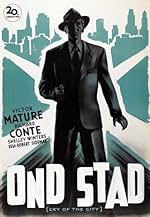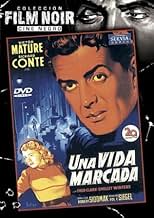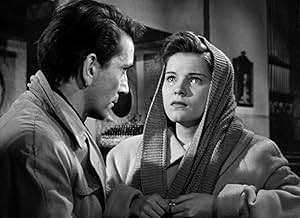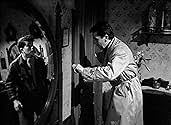Il tenente di polizia Candella, amico da lunga data della famiglia Rome, cammina sul filo del rasoio nel caso dell'assassino di poliziotti Martin Rome.Il tenente di polizia Candella, amico da lunga data della famiglia Rome, cammina sul filo del rasoio nel caso dell'assassino di poliziotti Martin Rome.Il tenente di polizia Candella, amico da lunga data della famiglia Rome, cammina sul filo del rasoio nel caso dell'assassino di poliziotti Martin Rome.
- Regia
- Sceneggiatura
- Star
- Premi
- 1 candidatura in totale
- Man
- (non citato nei titoli originali)
- Mama Roma
- (non citato nei titoli originali)
- Barber
- (non citato nei titoli originali)
- Mr. Masselli
- (non citato nei titoli originali)
- Elevator Operator
- (non citato nei titoli originali)
- Rosa
- (non citato nei titoli originali)
- Detective Loomis
- (non citato nei titoli originali)
Recensioni in evidenza
It's not as if Marty never had a choice. The film stresses the decency of Marty's upbringing. The family is 'deserving poor' - crucifix on the living-room wall, mother attending Mass every day, display case of war medals in the back room. Marty's girlfriend, Teena Riconti, is also from an honest family. So what turned Marty bad? This is analysed through the treatment of Tony, Marty's kid brother. Tony is on the cusp of manhood and beginning to adopt Marty's warped values. Can he be saved, or will he inevitably gravitate towards the "poolroom hotshots"?
Lest we conclude that moral depravity is the preserve of immigrants or even the urban poor, the film offers us Niles, the crooked lawyer. Played by Berry Kroeger with almost Wellesian flamboyance, Niles is the distillation of nastiness - a man with every advantage in life who still elects to sup with the devil. Twentieth-Century Fox's films noirs exhibited little love for attorneys, but Niles is probably the most unpleasant of them all.
Victor Mature and Richard Conte are in great form as Candella and Marty respectively. There is no real romantic sub-plot - Teena appears briefly at the beginning and the end, but plays no part in the story - and Candella is too busy making himself at home in the Rome household to go out and get a girl. Shelley Winters plays Brenda, one of Marty's dumb broads. For her, here in 1948, the typecasting had already begun.
As always, noir uses external scenery to symbolise internal emotion in the classic expressionist manner. Marty and Teena are filmed through the bars of the hospital bed-head, representing both the imprisonment awaiting Marty and the way in which Society is bearing down on these two, restricting their options. The hospital architecture is much vaster than the human scale, making a similar point - we like to think of ourselves as autonomous individuals, captains of our own destinies, but we are little more than insects, and the nest we have built around us dominates our existence. Marty's journey through the tunnel of the prison hospital is like an expressionist bad dream, a virtual street with pedestrians and vehicles, but no sky. Arches are everywhere. Marty's hospital ward is a forest of arch shapes. Niles' office has two arched windows whose insistent geometry dominates the screen. The church continues this motif with its lines of arches overhead. The city is our nest, and its institutions are the linked burrows through which we are obliged to scurry. Neon signs continually force themselves on our attention - the Gillette ad in the street, and the garage sign intruding through Rose Gibbons' apartment window. Just as with the terrific el-train shot, the city creeps into our consciousness, never allowing us to forget that we are living in its bowels.
Tony's moral crisis centres on the hard decisions which his bad-guy brother forces him to make. We see his hesitation when Marty tells him to take Candella's gun, then later when he is asked to steal the family's savings. In the church, the wall picture shows Christ falling with His cross. When, moments later, Candella the Christ-figure slumps to the pavement, it is Tony who (quite literally) supports the police.
And the leads are Victor Mature and Richard Conte. Mature is good as the upright cop who makes it personal to go after Richard Conte who has now committed the ultimate sin, he's killed a cop. But like a film a year earlier for Mature, Kiss Of Death, the film is dominated by Richard Conte who plays a charismatic and fascinating villain just as Richard Widmark did in Kiss Of Death.
Unlike Widmark who is a loner, Conte is charming and is ruthless in his use of that charm. The film opens with him seriously wounded after shooting a police officer. But he recovers and is in a prison hospital awaiting trial. It's the death penalty for sure, but Conte does in fact charm his way into an escape (I won't say how) and from then on because of his wound has to rely on a lot of help including his own family.
Some other standout performances including an old girl friend, Shelley Winters whom he has obtain an unlicensed physician to tend him. Hope Emerson who is as evil as she was as the prison matron in Caged, plays a masseuse who Conte uses to obtain traveling money as the woman is quite mobbed up. Tommy Cook plays Conte's hero worshiping younger brother who realizes just how much he and the family were being used in the climax.
Most of all there's Berry Kroeger who plays one of his usual slime ball characters as a criminal attorney who indulges in a bit of criminality himself most discreetly behind the scenes. Kroeger split parts like that with George MacReady back in the day and is always fascinating to watch.
Most of all there is Richard Conte who should have merited Oscar consideration in one of his best screen performances.
VICTOR MATURE and RICHARD CONTE are adversaries, one good, the other bad, buddies who grew up together on the city streets. Mature is a police lieutenant whose mission it is to find Conte once he's escaped from jail, with most of the story involved in Mature's search for the ruthless thug who has committed several serious crimes including murder.
The final scenes with Mature finally cornering Conte in a church are filled with high tension, thanks to director Siodmak's expert direction. He gets fully developed characterizations from his principal actors, as well as the supporting cast which includes FRED CLARK, DEBRA PAGET, TOMMY COOK, SHELLEY WINTERS and a standout turn from HOPE EMERSON as a woman intent on a jewel heist.
New Yorkers will be especially interested in seeing the Third Ave. El appearing prominently in one of the lower Manhattan scenes, as well as other Manhattan shots that show the city as it existed in '48. A classic example of '40s film noir.
What Ford was to the western, Hitchcock to suspense, Sirk to melodrama, so was Robert Siodmak to the noir. While "Cry of the City" is often left out of discussions of the genre, it is, in many ways a near perfect example of the genre.
By 1948 the noir was beginning to hit its stride. Siodmak came to this project with much valuable experience. His execution of this not especially remarkable story has a fluidity and assurance of style that one can only marvel at.
Despite the well worn cop vs. gangster tale, there is a potent psychological complexity at the core of "Cry of the City". Richard Conte's Martin Rome, is charismatic and charming. Not only does he work his magic on unsuspecting females, we the audience are firmly on his side at the start of the movie. As the plot unfolds his ruthless, selfish and manipulative motives become apparent. Yet it will take some time before we are completely convinced. It's a masterly stroke of screen writing. It will take Victor Mature's impassioned indictment to completely convince us.
Victor Mature is surprisingly competent in the lead in what must be surely one of his best roles. Richard Conte is simply superb in a complex and tricky role. His method is one of economy and subtlety and a lesson to screen actors. Despite a host of fine performances, Conte seems to not have garnered the respect he deserved.
A classic of its kind.
Lo sapevi?
- QuizThe film was set to be released under the title of "The Law and Martin Rome", when a lawyer from Baltimore, Maryland named Morton E. Rome contacted the studio threatening to sue, saying the film would damage his career and expose him to ridicule. Exhibitors were also objecting to the title, so to please them and avoid the suit the title was changed just before the film's release.
- BlooperPhantom Bullet: During the struggle in his office, Niles fires his gun, missing Marty but killing the woman eavesdropping outside the frosted glass door. Yet the glass does not shatter, nor is there a hole in the surrounding woodwork or plaster...as if the sound alone killed her.
- Citazioni
Martin Rome: I had enough of that when I'm a kid. Crummy tenements, no food, no clothes.
Lt. Vittorio Candella: Oh, save it for the jury, Marty. Who do you think you're kidding? l was brought up in the district too. I've heard that dialogue from you poolroom hotshots ever since l was ten years old. Get hip... only suckers work... don't be a square... stay with the smart money. Let the old man get the calluses digging the ditches. No food... no clothes... crummy tenements. You're breaking my heart, Marty.
- ConnessioniEdited into American Cinema: Film Noir (1995)
I più visti
- How long is Cry of the City?Powered by Alexa
Dettagli
- Data di uscita
- Paese di origine
- Siti ufficiali
- Lingue
- Celebre anche come
- Una vida marcada
- Luoghi delle riprese
- New York, Stati Uniti(Hester Street)
- Azienda produttrice
- Vedi altri crediti dell’azienda su IMDbPro
- Tempo di esecuzione
- 1h 35min(95 min)
- Colore
- Proporzioni
- 1.37 : 1






































